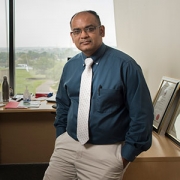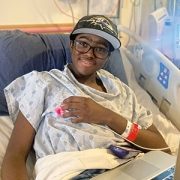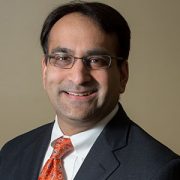Children’s National physicians provide education at 46th Annual Sickle Cell Disease Association of America Convention

Andrew Campbell, M.D., presented at the conference on the topics of hydroxyurea (HU) and blood transfusions.
More than 600 researchers, physicians, nurses, social workers and individuals living with sickle cell disease (SCD) and sickle cell trait (SCT) gathered in Baltimore for the 46th Annual National Sickle Cell Disease Association of America (SCDAA) Convention in mid-October. Children’s National physicians Andrew Campbell, M.D., director of the Comprehensive Sickle Cell Program, and Deepika Darbari, M.D., were among the speakers at the four-day convention discussing the latest scientific research and clinical information through seminars, panel discussions and symposiums.
Dr. Campbell presented at the conference on the topics of hydroxyurea (HU) and blood transfusions. He spoke to families about the benefits of HU, explaining how it lowers the percentage of sickle cells in the blood and decreases the overall inflammatory process. He stressed the importance of HU as a medication used in the prevention of SCD and emphasized the potential decrease in organ damage and increased overall survival rate of SCD patients. The importance of minor antigen blood group phenotyping was also discussed, as it can decrease the chance of patients rejecting future blood transfusions by developing new red blood cell antibodies.
“The indications for blood transfusions in the acute ‘ill’ setting can be life-saving and improve oxygen delivery and overall clinical outcomes within sickle cell complications, including acute chest syndrome, stroke and splenic sequestration. Approximately 10 to 15 percent of patients will need monthly blood transfusions for primary (i.e. stroke, patients with abnormal brain vessel TCD velocities >200cm/s) and secondary (i.e. patients with a previous stroke, multiple splenic sequestrations, recurrent priapism, recurrent acute chest syndromes) sickle cell complications,” explains Dr. Campbell.
Dr. Darbari, a hematologist at Children’s National, educated medical colleagues on chronic pain in SCD and emphasized the increase in pain from adolescence to adulthood.
“During childhood, pain in SCD is considered a consequence of discrete episodes of vaso-occlusion. Such vaso-occlusion is a complex process in which abnormally shaped (so-called ‘sickled’) red blood cells episodically obstruct the microcirculation thereby causing distal ischemia and resultant pain. As patients get older, mechanisms such as peripheral neuropathic or centralization may play important roles in transition and maintenance of chronic pain. It is important to consider underlying mechanisms contributing to pain when managing a patient with SCD,” states Dr. Darbari. She referenced her coauthored and published Analgesic, Anesthetic and Addiction Clinical Trial Translations Innovations Opportunities and Networks (ACTTION)-American Pain Society Taxonomy (AAPT) criteria for classifying chronic pain in SCD and how useful this tool can be for physicians in the treatment of patients with SCD.
Both Drs. Campbell and Darbari shared their expertise on different facets of SCD with families and medical professionals alike. Their impactful work is paving the way for future treatments and pain management techniques for treating patients living with SCD and their families.









